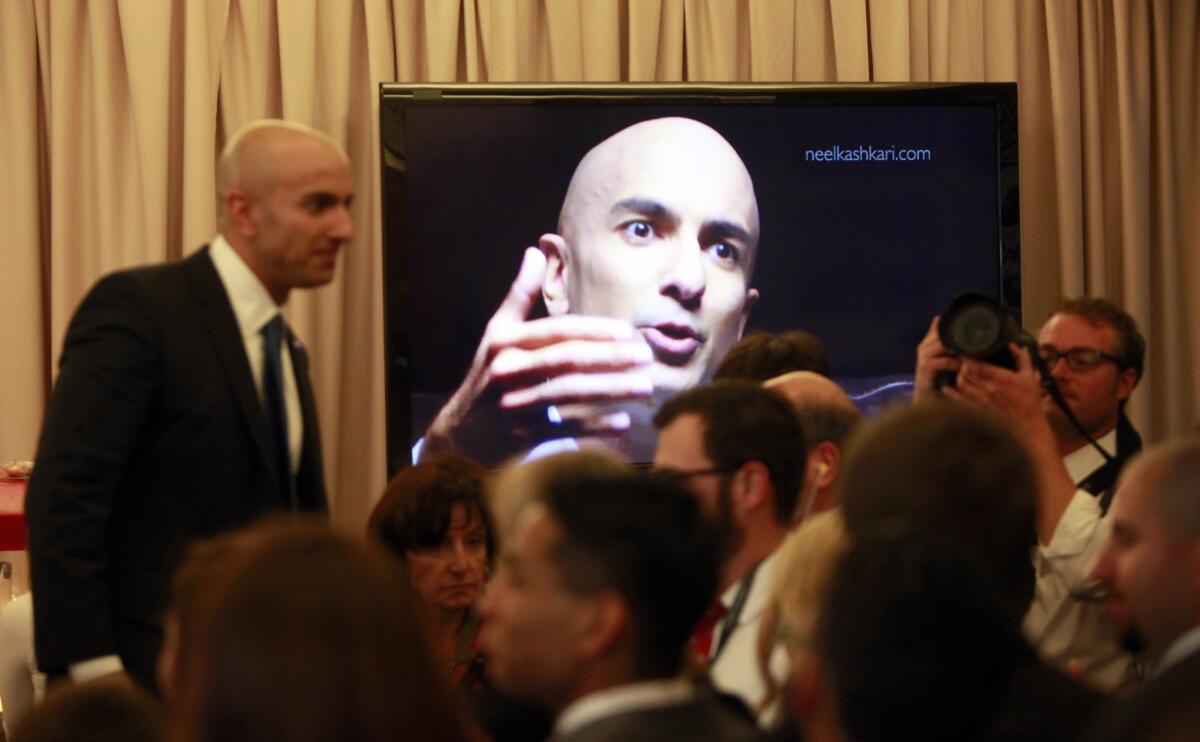New data indicate bleak future for California GOP unless it retools

- Share via
From SACRAMENTO — The big picture keeps getting bleaker for the California Republican Party. Young voters aren’t joining. Neither are Latinos and moderates.
Elderly white conservatives dominate the shrinking state GOP. And they don’t offer much of a future.
If you’re a committed Republican, it’s already depressing in California. No Republican holds statewide office. Republicans are outnumbered by Democrats at least two to one in the state’s U.S. House delegation, the state Senate and the Assembly.
Indicative of the Democratic dominance is the GOP’s tumbling voter registration, down at last count to 28.4%. Democratic registration also has fallen, but less precipitously, to 43.4%. Independents — those expressing no party preference — have climbed to 21.2%.
New data from the nonpartisan Public Policy Institute of California profiling likely voters don’t offer much hope for the GOP. Demographics — especially ethnicity and age — are not favorable to Republicans.
“All of the trends are working against the Republican Party in California,” says Mark Baldassare, the institute’s president and pollster, who based his research primarily on statewide polling in the last year.
For example:
• Among Republican likely voters, only 11% are under age 35. But 50% are 55 or over. By contrast, 20% of Democratic likely voters are under 35, with 45% topping 55. Independents are even more youthful.
• More than two-thirds of Republican likely voters, 69%, call themselves conservatives. Less than one-third identify themselves as moderates or — heaven forbid — liberals. Among all voters, regardless of party, 63% are liberals or moderates, indicating how far out of the California mainstream Republicans are.
• In a reverse of the historical pattern, slightly more Democrats than Republicans — 59% to 55% — now feel a “strong affiliation” with their party. In other words, they feel a stronger bond.
• Three-fourths of Republican likely voters are white. Just half the Democratic voters are. Whites make up only 44% of California adults, but represent 62% of the likely voters. That’s because the fast-growing Latino population still hasn’t lived up to its voting potential. Latinos are 34% of the adult population but a mere 17% of the likely voter mix.
• Among Latinos who are likely to vote, only 18% are Republicans; 59% are Democrats and 17% are independents.
“Latinos continue to be underrepresented” at the ballot booth, Baldassare says. “And I don’t think it’s improving dramatically.”
But if Latinos ever do start voting their numbers, the GOP really will be swamped unless the party changes its colors.
And Roger Salazar, a Democratic consultant and advisor to the Legislature’s 24-member Latino Caucus (only Dems allowed), predicts more frequent voting soon.
“It used to be there was a big information gap” between Latinos and whites, Salazar says. “That’s changing with mobile technology, with those hand-held devices. Now young Latinos are becoming better informed, so I see them getting more active.”
What can Republicans do to get their votes? Change their rhetoric on immigration, Salazar and most other political experts say.
Latinos “haven’t felt any love from the Republican Party,” he says. “It’s hard to vote for anyone you feel doesn’t like you. If I think you don’t like my cousin, I may not like him either, but if you don’t like him, I’ll like you even less.”
Rob Stutzman, a Republican consultant, says “there’s a social stigma, especially with young people, about registering as Republican.”
That’s particularly true of millennials, he says. “They feel strongly about being libertarian on social issues such as marriage. The [Republican] Party they see on TV is largely portrayed by old white men in the South. All you need is a few of them to stand out and it makes you uncomfortable.”
Allan Hoffenblum, a former Republican consultant who publishes the California Target Book, which handicaps legislative and congressional races, says: “The party needs a modern-day Ronald Reagan — not a 1980s Ronald Reagan, but one more in tune with the culture of California than the current Republican Party is.”
That political Pied Piper won’t be the Republican gubernatorial candidate, former U.S. Treasury official Neel Kashkari. He’s a virtual cinch loser to Democratic Gov. Jerry Brown. But Kashkari does seem to be charting a path that could start to lead the GOP out of the wilderness.
Very much unlike a typical Republican candidate, Kashkari marched in a San Diego gay pride parade, has spoken at black churches, spent a week posing as a homeless man in Fresno and campaigned on Univision.
“We need to have candidates who reflect the new demographics,” says the son of Indian immigrants. “If our candidates reflect the diversity of the state, it will bring these groups back.”
Kashkari has the right idea — if not the statewide ID, or the credentials and cash.
Hoffenblum thinks the real test for the GOP will come in four years, when Brown is termed out.
“Will there be a serious Republican or a no-party preference candidate or two Democrats running in November” he says, adding that the latter “would mean the complete collapse of the Republican Party.”
A one-party state would be undemocratic and wouldn’t work for California. It’s too diverse. Hopefully the GOP will retool. Kashkari might be showing how.
george.skelton@latimes.com
Twitter: @LATimesSkelton
More to Read
Sign up for Essential California
The most important California stories and recommendations in your inbox every morning.
You may occasionally receive promotional content from the Los Angeles Times.














